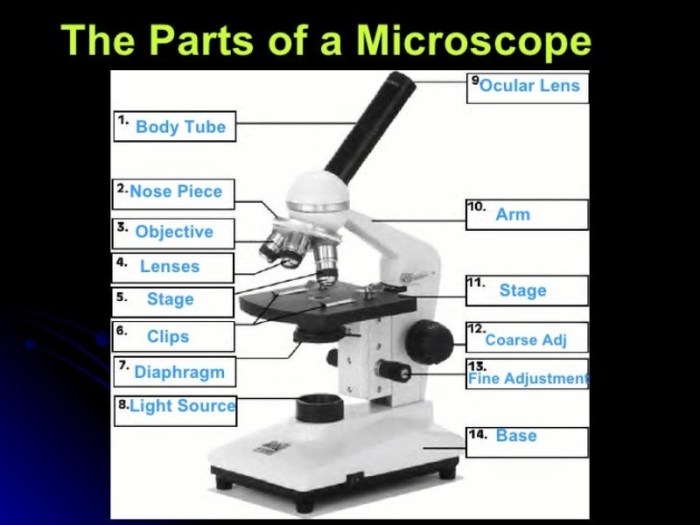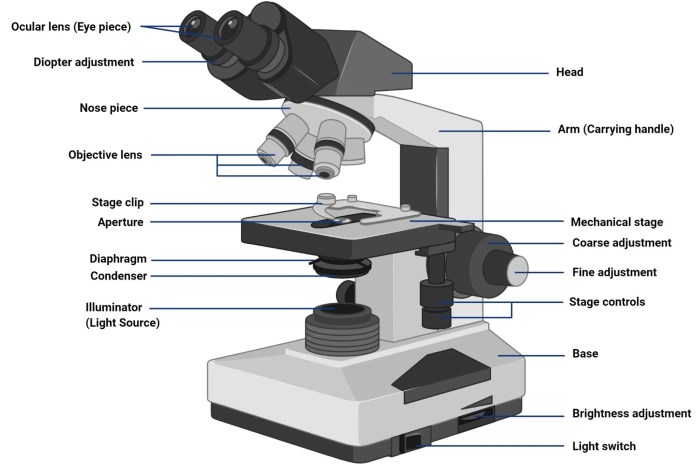What is the difference between the ocular and objective lenses? This question delves into the captivating realm of optics, where understanding the distinct roles of these lenses is paramount. Ocular lenses, situated at the eyepiece end, magnify the image formed by objective lenses, which gather and focus light from the specimen.
Together, they constitute the fundamental components of optical instruments, enabling us to explore the unseen world with remarkable clarity.
As we embark on this journey, we will unravel the optical properties, construction, and applications of both ocular and objective lenses. We will delve into the intricacies of magnification and image formation, uncovering the secrets behind the breathtaking images captured by microscopes and telescopes.
Optical Properties
Ocular lenses are designed to magnify images, while objective lenses are used to gather light and focus it on the specimen. The optical properties of these lenses determine their performance and applications.
Optical Properties of Ocular Lenses
- Magnification: Ocular lenses have a fixed magnification, typically ranging from 5x to 20x.
- Field of view: The field of view refers to the area of the specimen that can be observed through the ocular lens.
- Eye relief: Eye relief is the distance between the last lens surface and the observer’s eye.
Optical Properties of Objective Lenses
- Numerical aperture (NA): The NA is a measure of the lens’s ability to gather light and resolve fine details.
- Working distance: The working distance is the distance between the front lens element and the specimen.
- Focal length: The focal length determines the magnification of the lens.
Construction and Design

Ocular and objective lenses differ in their construction and design to meet their specific functions.
Construction and Design of Ocular Lenses
Ocular lenses are typically constructed using multiple lens elements, often in a symmetrical arrangement. They are designed to provide a sharp and clear image while minimizing distortions.
Construction and Design of Objective Lenses
Objective lenses are more complex in construction, consisting of several lens elements arranged in a specific configuration. They are designed to collect light from the specimen and focus it onto the image plane, while minimizing aberrations and providing a high degree of resolution.
Magnification and Image Formation

Ocular and objective lenses play distinct roles in magnification and image formation.
Magnification Capabilities of Ocular Lenses
Ocular lenses provide the final magnification of the image observed through the microscope. The total magnification is calculated by multiplying the magnification of the objective lens by the magnification of the ocular lens.
Image Formation Using Objective Lenses
Objective lenses gather light from the specimen and focus it on the image plane. The quality of the image formed depends on the optical properties of the objective lens, such as its NA and working distance.
Applications and Uses: What Is The Difference Between The Ocular And Objective Lenses

Ocular and objective lenses have a wide range of applications in various fields.
Applications and Uses of Ocular Lenses
- Microscopy: Ocular lenses are essential components of microscopes, providing magnification and allowing the observation of small specimens.
- Photography: Ocular lenses can be used in conjunction with cameras to capture images through microscopes.
Applications and Uses of Objective Lenses, What is the difference between the ocular and objective lenses
- Microscopy: Objective lenses are the primary components of microscopes, responsible for gathering light and focusing it on the image plane.
- Imaging: Objective lenses are used in various imaging applications, such as microscopy, endoscopy, and optical microscopy.
- Spectroscopy: Objective lenses are employed in spectroscopy to focus light onto the sample and collect the resulting signal.
Top FAQs
What is the primary function of an ocular lens?
Ocular lenses magnify the image formed by objective lenses, allowing the observer to view the specimen with enhanced detail and clarity.
How do objective lenses differ from ocular lenses?
Objective lenses gather and focus light from the specimen, creating an image that is then magnified by the ocular lenses.
What factors determine the magnification power of an optical instrument?
Magnification power is determined by the focal lengths of both the ocular and objective lenses, as well as the distance between them.